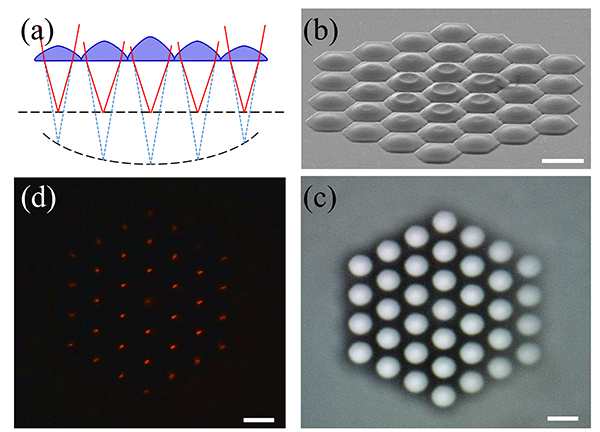Field curvature is a widespread matter in large field optical imaging systems, which means even if you are imaging a planar object, you can only achieve high sharpness at the focus position, and the image in the edge area may become blur. However, the existing optical systems and imaging components are mostly planar designs, so it is particularly important to eliminate field curvature aberrations.
As a natural biomacromolecular material, the protein materials have the advantages of wide source, renewable, biocompatible, non-polluting, and absorbable degradation. In recent years, with the help of growing maturity of micro-nano processing technology, many special functions of protein-based micro-nano structures, including micro-devices and even integrated systems have been successfully realized.
Based on hereinbefore background, the researchers from the group of Prof. Hong-Bo Sun (the Key Laboratory of Integrated Optoelectronics of Jilin University) demonstrated a three-dimensional microlens array with different curvature unit lenses (MLADC) based on bovine serum albumin (BSA) fabricated by femtosecond laser two-photon polymerization direct writing (FsDLW). The MLADC possesses unique and characteristic optical performance, as the curvatures of unit lenses are different along with their different positions, which will play a significant role in optimizing optical system structure and reducing optical elements, especially in field curvature correction. In addition, due to the unique advantages of FsDLW, such as non-contact and low thermal damage, the biological activity of the protein is partially retained. Therefore, it is easy to achieve a fine adjustment of the focal plane by utilizing the equilibrium swelling of the protein hydrogel in the solution. These results are reported in Chinese Optics Letters Vol. 17, No. 6 2019 (Zhishan Hou, et al., Tunable protein microlens array).
“These results show the application prospects of protein-based materials in new biophotonics and biomedical fields, indicating the great potential of femtosecond laser direct writing technology in building "smart" integrated photonic micro/nano-biological systems,” said Dr. Zhi-Shan Hou from this group.
Their further work will focus on the dual controllable design of femtosecond laser direct writing in device geometry and material functional properties, and give the device novel and diverse features and functions by fully exploiting and utilizing the intrinsic properties of proteins.

Fig (a) Working principle of the microlens array, (b) scanning electron microscope (SEM) characterization, (c) microscope photographs, (d) dark field focus image.


